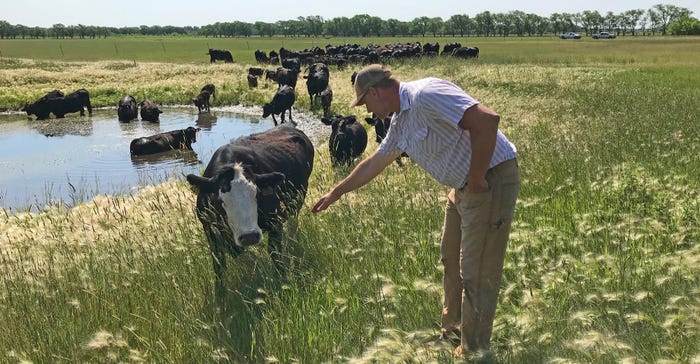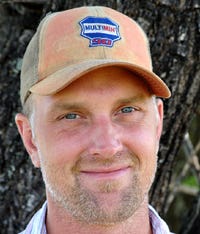November 23, 2020

Mark Larson waded through tall pasture grass to the rotationally grazed paddock where a bellowing herd of 85 SimAngus cow-calf pairs crowded the single-strand electric fence between them and fresh fodder.
When Larson appears, the cattle know they’re about to be let into the next paddock.
On this 270-acre pasture, Environmental Quality Incentives Program (EQIP) assistance from the USDA’s Natural Resources Conservation Service offset the cost of fencing, well drilling and watering systems. The infrastructure ensures a constant supply of fresh water, which leads to healthier livestock and a more productive pasture.
Annual payments tied to a three-year prescribed grazing contract are NRCS’ incentive to follow its grazing plan. Producers pay for the infrastructure upfront. EQIP provides partial reimbursement.
Throughout Kittson County, 40-some NRCS-supported grazing plans encompass about 13,510 acres. Most of that land was previously hay ground. The rest was converted from marginal cropland.
“Yes, it is an investment. But once they’re done with it, they find out it works,” says NRCS district conservationist Jim Schwab.

Larson, 37, has managed the 500-cow grazing operation for Three Branch Ranch, a family farm near Hallock that involves Mark and his wife, Nikki; her parents, Lowell and Julie Younggren; and her brother and his wife, Nathan and Tori Younggren.
At their own farm east of Lancaster, the Larsons raise registered SimAngus bulls. Larson worked for five years as an NRCS soil conservation technician — where his job included writing grazing plans — before he joined the family operation full time in in 2013.
Managing the half-dozen pastures — three of them rotationally grazed — involves moving cattle, treating any sick animals, fixing fences and maintaining water systems. Elk sometimes damage the fences. Gophers sometimes chew through the plastic pipelines buried 18 inches underground.
Larson says following the NRCS grazing plan required more intensive management. If things get busy elsewhere on the farm, it’s no longer possible to leave cattle in the same pasture for a month.
Despite the extra work, Schwab says everyone who received a grazing plan continued to follow it after the three-year contract expired.
“They’re going to tell you they’ll never go back. They’ll never abandon the water,” Schwab says.
The well, pipeline and tanks ensure a fresh water supply in years when the ponds dry up. Cleaning sediment out of a pond can cost $8,000 a year.
Nearly 20 years ago, the section of pasture where Larson was moving cattle became the first in Kittson County to try an alternative to continuously grazed pasture. Lowell fenced off four paddocks and added ponds with NRCS’ EQIP assistance.
Nathan’s subsequent NRCS prescribed grazing sign-up added about $43,000 worth of infrastructure to the 270-acre Hazelton Township site: 7,200 feet of fencing along the Middle Branch Two Rivers River, 10,000 feet of paddock fencing; a new well and pumping plant, 8,300 feet of shallow buried pipeline and six watering tanks. The three-year EQIP contract provided annual payments of $10,000.
Seeing the benefits
“One of the biggest benefits I believe is the distribution of grazing because of the location of water,” Larson says.
In larger pastures, cattle graze heavily near the ponds but won’t venture far if they have to walk back at night to drink. The fresh water allows them to really utilize all the forage within each paddock.
Larson added that the calves are healthier, too.
“[The fence] allows these calves to always be able to move ahead,” he says. “They just gravitate toward the freshest, greenest grass. So instead of being stuck in the same old spot with their mom until they move, they’ll stay near. They’ll just move under the fence.”
Calves on pasture don’t get supplemental grain. That would require moving the feeders from paddock to paddock.
“Knowing that they have the grass in front of them, we’d rather look at low-input type gain,” Larson says. “We don’t weigh [most of the] calves. We don’t track that part of it. But just knowing that they always have fresh grass in front of them, we know that’s correlating into weight gains.”
Many producers established one pasture and then kept adding more. The Younggrens and Larsons have held four grazing contracts totaling 1,084 acres among them, including one in the farm’s name that’s currently being carried out. After Three Branch Ranch restructures to reflect families’ growth, Larson says he may pursue another on 320 acres that came out of the Conservation Reserve Program in 2019.
“Once we see it works or we see the benefits of what’s going on with it, we’ll say, ‘OK, it’s time to add another piece.’” he says. “People kind of figure out different ways to graze it. From the first grazing system we’ve done to this next one we’re going to do, there’s always something you’re looking at a little bit more critically.”
This year, Larson tried dividing paddocks in half with a temporary fence to more intensively and evenly graze each segment of pasture. He says the poly wire with step-in posts worked well.
“The experiment comes after they come in and get a plan and put it on the ground,” Schwab says. “You found out how long the animals can stay. You find out every year how long they’ll stay out there.”
On the half-dozen pastures Larson has managed, the grazing season usually ran from late May to mid-October.
Schwab often hears from producers who have seen how prescribed grazing has worked for neighbors. A new generation of producers ready to make changes has brought more sign-ups.
“As you have maybe a younger group coming in there, or you have producers that are having some of these issues with fresh water, that really draws them in. It’s an investment,” Larson says. “But the cost-share dollars and even the incentive payment is something that, especially in economic times like this, there’s some benefits in going through the work.”
With rotational grazing, cattle fertilize and plant as they graze, working the seed in with their hooves. Moving cattle to a new paddock when 4 inches of forage remains exposes forbs to sunlight.
“You enhance the diversity,” Schwab says. And higher-protein plants such as clover and alfalfa translate into weight gain.
NRCS grazing plans consider forage availability, a planting plan, paddock layout, and water system requirements and design.
The fences, water tanks and waterlines have a 20-year lifespan.
“If you start to look at taxpayers’ dollars going into infrastructure, it’s truly beneficial to the taxpayer having something that’s built to go through maybe two generations,” Schwab says.
Watch a YouTube video about Laron’s rotational grazing below.
For more information, visit nrcs.usda.gov
Wessel is an information officer with the Minnesota Board of Water and Soil Resources.
Source: Minnesota Board of Soil and Water Resources, which is solely responsible for the information provided and is wholly owned by the source. Informa Business Media and all of its subsidiaries are not responsible for any of the content contained in this information asset.
You May Also Like




